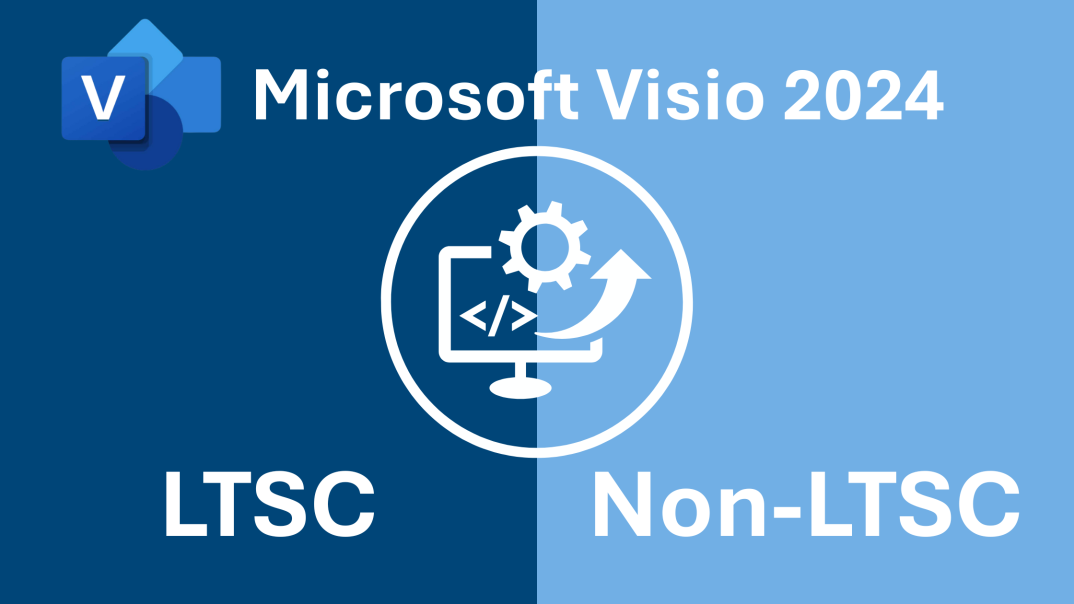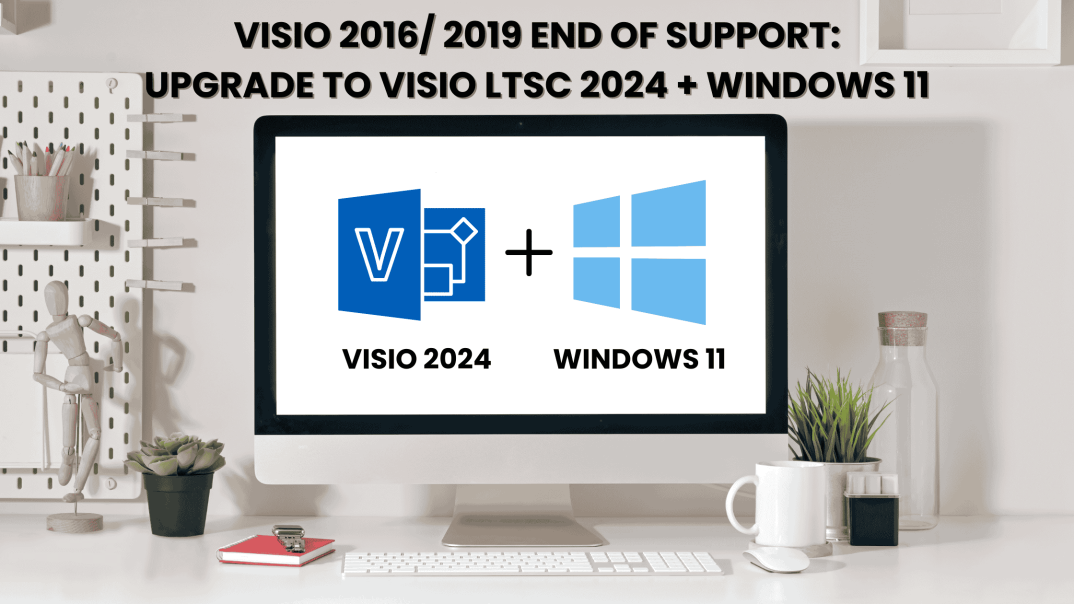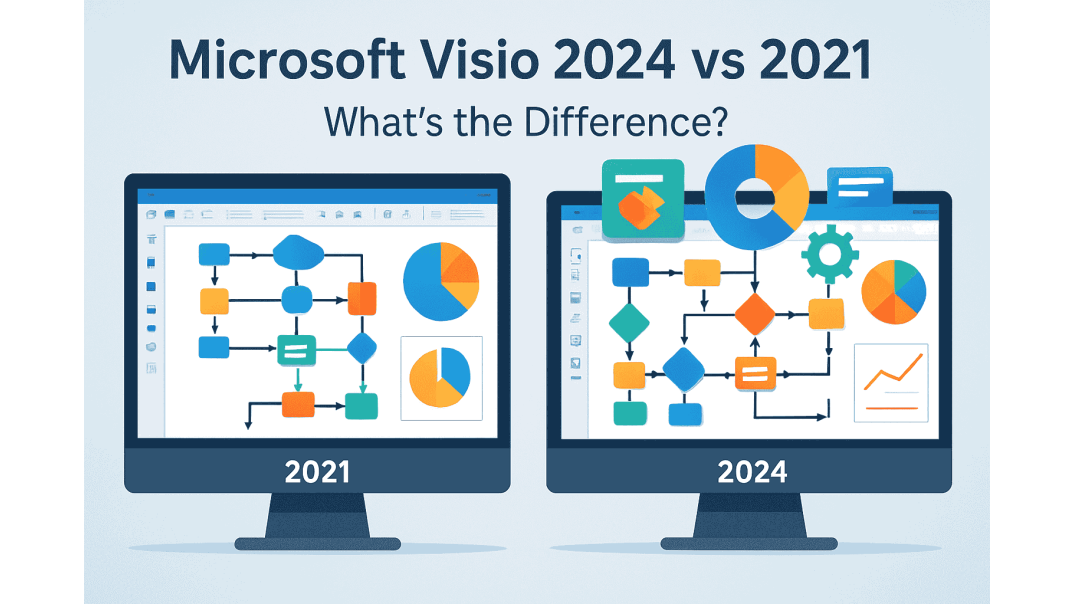Visio 2024 LTSC vs. Non-LTSC
When it comes to Microsoft Visio 2024, a key question for IT teams and decision-makers is whether to opt for the LTSC version or the Non-LTSC version. If you’re unclear on what LTSC even means, or how it impacts your workflows, licensing, and long-term costs, don’t worry. This guide will break it all down and help you make the right call for your organization.
What Is LTSC?
LTSC stands for Long-Term Servicing Channel. It’s built for organizations that want stability and predictability.
Here’s what that means:
- No feature changes after release
- 5-year support cycle
- Security and reliability updates only
- Consistent performance for the software’s lifetime
Think of LTSC as the “fixed” version of Visio — ideal for environments where change control is critical.
What Is Non-LTSC (Perpetual Version)?
Non-LTSC refers to the standard perpetual version of Visio 2024, not a subscription or cloud-based product.
Unlike LTSC, the Non-LTSC release:
- May receive feature and performance updates periodically
- Can include integration improvements with newer Office builds
- Offers a more flexible upgrade path to future versions
It’s still a one-time purchase (perpetual license), but with slightly more flexibility and modern compatibility than LTSC.
In simple terms:
- LTSC = Fixed version
- Non-LTSC = Slightly evolving version, still perpetual
Key Differences Between Visio 2024 LTSC and Non-LTSC
| Feature | Visio 2024 LTSC | Visio 2024 Non-LTSC |
|---|---|---|
| Licensing | One-time purchase (perpetual) | One-time purchase (perpetual) |
| Updates | No new features after release | Regular updates, new features monthly |
| Support Lifecycle | 5 years of mainstream support | Standard Microsoft Office support timeline |
| Cloud Integration | Minimal or none | Limited (can connect to SharePoint/OneDrive if enabled) |
| AI Features | Limited or none | Broader compatibility with newer Office integrations |
| Compatibility | Ideal for static environments | Better suited for hybrid or semi-modern IT setups |
| Cost | One-time cost | One-time cost (similar pricing) |
Feature Breakdown
1. Updates and Feature Improvements
- LTSC versions are locked after release — no new features or design updates.
- Non-LTSC can receive compatibility and minor feature updates that align it more closely with modern Office tools (Word, Excel, PowerPoint).
Verdict:
- Choose LTSC if you value strict stability.
- Choose Non-LTSC for occasional improvements without switching to subscription software.
2. Licensing and Ownership
- Both LTSC and Non-LTSC are perpetual licenses. You buy once and own it.
- The difference is:
- LTSC follows the Long-Term Servicing Channel, meaning it receives no significant updates.
- Non-LTSC aligns with the General Availability (GA) release, which can receive incremental enhancements during its lifecycle.
Verdict:
- Both models avoid recurring payments, but Non-LTSC offers a slightly more flexible lifecycle.
3. Integration with Microsoft 365
- Even though Non-LTSC is not subscription-based, it’s more compatible with Microsoft 365 environments.
- You can open files from OneDrive or SharePoint, and it plays nicely with modern Office file formats.
- LTSC, by contrast, is meant for isolated or offline networks where cloud connectivity is restricted.
Verdict:
- If you’re mixing cloud and on-premise tools, Non-LTSC is the more convenient option.
4. Performance and Environment Control
- LTSC excels in highly controlled or secure environments where change is tightly managed and software versions are locked for extended periods.
- Non-LTSC fits well in flexible IT ecosystems that still prefer one-time licenses but need compatibility with newer Windows or Office builds.
Verdict:
- LTSC = Predictability
- Non-LTSC = Compatibility
When to Choose Visio 2024 LTSC
Choose Visio 2024 LTSC if:
- You require a stable, fixed software version.
- You operate in an offline or high-security environment.
- You require reliable, long-term support with minimal ongoing maintenance.
- You want zero unexpected feature changes.
Best for:
- Government and defense sectors
- Healthcare and regulated industries
- Industrial and infrastructure setups
- Air-gapped or offline IT environments
When to Choose Visio 2024 Non-LTSC
Choose Visio 2024 Non-LTSC if:
- You want a modern perpetual license that stays compatible with new systems.
- You prefer occasional performance or integration updates.
- You’re running newer versions of Windows or Office.
- You don’t want a subscription model but still want a product that evolves modestly over time.
Best for:
- Medium to large organizations with active IT management
- Hybrid workplaces
- Businesses upgrading from older perpetual Visio versions
- Teams that work with cloud-connected Microsoft tools
Real-World Scenarios
Scenario 1: A Power Utility Company
They run secure, isolated systems and don’t want any software changes after deployment.
Best Fit: Visio 2024 LTSC
Scenario 2: An Engineering Firm Using Microsoft 365 Locally
They require local software that remains compatible and syncs seamlessly with Office 2024 and SharePoint files.
Best Fit: Visio 2024 Non-LTSC
Final Thoughts: Which One Is Right for You?
| You Should Choose… | If You… |
|---|---|
| Visio 2024 LTSC | Need maximum stability, work offline, or manage sensitive systems |
| Visio 2024 Non-LTSC | Want modern compatibility and performance updates without moving to a subscription model |
❗Compatibility Note: Mixing Visio LTSC and Non-LTSC editions is not possible. Each version of Visio 2024 is compatible only with the corresponding Office 2024 edition.
| Visio 2024 Version | Office 2024 (Non-LTSC) | Office 2024 LTSC |
|---|---|---|
| Visio 2024 Professional (Non-LTSC) | ✅ Compatible | ❌ Incompatible |
| Visio 2024 LTSC Professional | ❌ Incompatible | ✅ Compatible |
Quick Recap:
- LTSC = Fixed, locked, long-term version
- Non-LTSC = Slightly evolving, perpetual version with better modern compatibility
- Both are perpetual licenses, with the key difference being how locked down or adaptable you want your Visio environment to be.
Conclusion
Choosing between Visio 2024 LTSC and Non-LTSC depends on how much flexibility you want in your software lifecycle.
If you prefer fixed, unchanging reliability, go LTSC. If you prefer a modern, perpetual version that remains compatible with evolving Microsoft environments, go Non-LTSC. Both deliver professional-grade diagramming power, and the right choice depends on your IT strategy and operational needs.
🛒 Ready to decide?
👉 Buy Visio 2024 LTSC – For long-term stability and control.
👉 Buy Visio 2024 Non-LTSC – For flexibility and broader compatibility.
Need help choosing? Reach out to Brytesoft’s support team for expert guidance.
FAQ About Visio 2024 LTSC vs. Non-LTSC: Key Differences You Need to Know
Is Non-LTSC a subscription?
No. Both LTSC and Non-LTSC are perpetual, one-time purchases. Non-LTSC simply has a different update channel.
Will LTSC or Non-LTSC get AI or Copilot features?
No. Those are available only in Visio for Microsoft 365 (subscription edition).
Can I use both LTSC and non-LTSC in the same organization?
Yes. Many organizations deploy LTSC in secure departments and Non-LTSC in general operations.
Is Visio 2024 LTSC compatible with older Visio files?
Yes. Visio 2024 LTSC supports opening and editing files created in earlier versions, such as Visio 2016, 2019, and 2021. This ensures seamless migration for teams upgrading their systems without losing access to legacy diagrams or templates.
Can I deploy Visio 2024 LTSC across multiple offline devices?
Yes. Visio 2024 LTSC is ideal for offline or air-gapped deployments. Once activated, it does not require an internet connection for daily use, making it perfect for secure, isolated environments that require tight control over software behavior.






